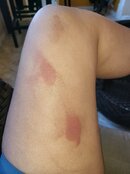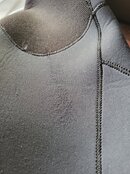You are using an out of date browser. It may not display this or other websites correctly.
You should upgrade or use an alternative browser.
You should upgrade or use an alternative browser.
fire coral
- Thread starter sueellen
- Start date
Please register or login
Welcome to ScubaBoard, the world's largest scuba diving community. Registration is not required to read the forums, but we encourage you to join. Joining has its benefits and enables you to participate in the discussions.
Benefits of registering include
- Ability to post and comment on topics and discussions.
- A Free photo gallery to share your dive photos with the world.
- You can make this box go away
Sueellen,
Do nothing, expect the redness to disappear completely.
In the future, if you touch fire coral don't touch the affected area. Immediately fan the area with water. If you touch the area, fanning will not help. I usually have no symptoms by the time the dive is over if I fan during the dive.
If I touch the area before I remember to fan, I always apply topical Benadryl which works for me. Keep in mind, I am not a physician and am only telling you what has worked for me. As always, consult your physician before using any medication.
Bill, how's that for a disclaimer?
DSSW,
WWW
Do nothing, expect the redness to disappear completely.
In the future, if you touch fire coral don't touch the affected area. Immediately fan the area with water. If you touch the area, fanning will not help. I usually have no symptoms by the time the dive is over if I fan during the dive.
If I touch the area before I remember to fan, I always apply topical Benadryl which works for me. Keep in mind, I am not a physician and am only telling you what has worked for me. As always, consult your physician before using any medication.
Bill, how's that for a disclaimer?
DSSW,
WWW
BillP
Senior Member
Good disclaimer, Walter.
Sueellen, it would be pretty hard for coral to sting a diver through a wetsuit. A lycra diveskin maybe, but not a neoprene suit unless they bumped so hard the suit tore. If someone bumps coral that hard they have to be concerned about cuts and scrapes in addition to stings. You can read more about coral injuries on DAN's website at:
http://www.diversalertnetwork.org/medical/faq/faq.asp?faqid=125
HTH,
Bill
Sueellen, it would be pretty hard for coral to sting a diver through a wetsuit. A lycra diveskin maybe, but not a neoprene suit unless they bumped so hard the suit tore. If someone bumps coral that hard they have to be concerned about cuts and scrapes in addition to stings. You can read more about coral injuries on DAN's website at:
http://www.diversalertnetwork.org/medical/faq/faq.asp?faqid=125
HTH,
Bill
Fanning the area underwater is truly the secret, it helps remove the stinging cells. When I first heard that I thought someone was pulling my leg but it really does work!
However, if you do instinctively touch it, try not to rub it too hard. One thing I have found that works well Immediately afterwards is to use a small scrub pad (like Scotch Brite) soaked in vinegar. Gently scrub the area. This will help drag out any of those stinging cell that haven't released their toxins yet. There is a product sold in dive shops that is similar to this...but I can't think of the name!
As Walter also said, Benadryl cream works well on the rash. The redness can last up to several weeks, depending on how severe the exposure was, but it will fade completely.
However, if you do instinctively touch it, try not to rub it too hard. One thing I have found that works well Immediately afterwards is to use a small scrub pad (like Scotch Brite) soaked in vinegar. Gently scrub the area. This will help drag out any of those stinging cell that haven't released their toxins yet. There is a product sold in dive shops that is similar to this...but I can't think of the name!
As Walter also said, Benadryl cream works well on the rash. The redness can last up to several weeks, depending on how severe the exposure was, but it will fade completely.
The usual cause for coral rashes is brushing against hydroid and coral growth with the open skin - usually a wet suit is protective, as BillP states. Minute cuts and scrapes are added to the effects of the nematocytes. Fanning salt water is a great way to rid the nematocytes; fresh water and alcohol will cause them to fire off.
Coral scrapes do have a tendency to become both chronically irritated and secondarily infected. Occasionally coral scrapes and cuts will have trouble healing or will try to heal and then break out in a chronic dermatitis or weeping wound. This is thought to be due to the persistent toxic or allergic effects of the small bits of coral (often microscopic) that are embedded in the wound at the time of the injury. That's why Dee's Scotch Brite pad is such a good idea.
http://www.scuba-doc.com/otherderms.htm
Initially, when out of the water, wounds should be flushed out with copious quantities of vinegar. For deeper wounds, Tetanus prophylaxis should be given and the wound treated with a combination of triple antibiotic/steroid cream until healing occurs.
If the wound does not appear to be healing after 24-36 hours, it might be wise to check in with your doctor for opinion and possible debridement
(removal of foreign bodies). Hyperpigmentation (dark, color changes) can occur and are more difficult to manage and require the assistance of a good dermatologist.
Best regards for safe diving!
Ern Campbell, MD
Diving Medicine Online
http://www.scuba-doc.com/
Coral scrapes do have a tendency to become both chronically irritated and secondarily infected. Occasionally coral scrapes and cuts will have trouble healing or will try to heal and then break out in a chronic dermatitis or weeping wound. This is thought to be due to the persistent toxic or allergic effects of the small bits of coral (often microscopic) that are embedded in the wound at the time of the injury. That's why Dee's Scotch Brite pad is such a good idea.
http://www.scuba-doc.com/otherderms.htm
Initially, when out of the water, wounds should be flushed out with copious quantities of vinegar. For deeper wounds, Tetanus prophylaxis should be given and the wound treated with a combination of triple antibiotic/steroid cream until healing occurs.
If the wound does not appear to be healing after 24-36 hours, it might be wise to check in with your doctor for opinion and possible debridement
(removal of foreign bodies). Hyperpigmentation (dark, color changes) can occur and are more difficult to manage and require the assistance of a good dermatologist.
Best regards for safe diving!
Ern Campbell, MD
Diving Medicine Online
http://www.scuba-doc.com/
cosmic_lobster
New
In Cozumel, I came up with red splotches on my thigh that found upon removing my wetsuit. I didn't feel much during the dive, though. I was wearing a full 5mm wetsuit. The only thing seeming reasonable was fire coral. There was a lot of it where we were. After looking at my wet suit there was a fine abrasion on its surface right in the area. Days later, still dealing with itching and dermatitis. So, I believe it can penetrate. I'm so glad I had the suit on, otherwise it would have been much, much worse.
Attachments
I am to my fellow divers as a sacrificial anode is to a boat hull--If there are stings to be stung, I get them (although it's been a few decades since my last brush with fire coral). For me, vinegar is the key, although I had a gnarly hydroid sting from a reckless encounter with a mooring line a couple of weeks ago which required a few days of Benedryl.
Sorry this happened, and thanks for the photos!In Cozumel, I came up with red splotches on my thigh that found upon removing my wetsuit. I didn't feel much during the dive, though. I was wearing a full 5mm wetsuit. The only thing seeming reasonable was fire coral. There was a lot of it where we were. After looking at my wet suit there was a fine abrasion on its surface right in the area. Days later, still dealing with itching and dermatitis. So, I believe it can penetrate. I'm so glad I had the suit on, otherwise it would have been much, much worse.
Best regards,
DDM
Similar threads
- Replies
- 5
- Views
- 739
- Replies
- 33
- Views
- 1,904
- Replies
- 101
- Views
- 6,474
- Replies
- 0
- Views
- 359






